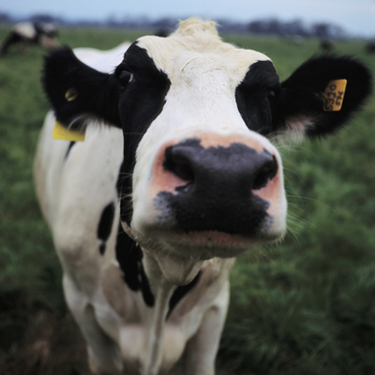
One price wasn't listed, organic milk produced locally. It can be a little harder to source and costs a little extra but it is worth it. It's not Gucci-milk. And it shouldn't necessarily be cheaper because it is local. It's what milk should cost. Getting the lowest price may be okay for what fuels our cars but not what fuels our bodies. Whether it is milk or cookies, we need to be okay with spending a little more on our food. There is a lot of truth in the saying, "you are what you eat." and in the case of cheap food, "you get what you paid for."
Stapled to the receipt was an article my Dad had clipped from the Cleveland Plain Dealer about how conventional, dairy farmers where being impacted by the increase in feed costs, a.k.a. grains, like corn and soy. Higher feed costs drives up the price of milk and other food. If all dairy cows were pasture-raised, farmers wouldn't be as vulnerable to the fluctuations in feed prices. But more importantly, the cows would be eating a diet they were designed for...grass. Cows' digestive systems - with their five stomachs - weren't designed to eat corn and other grains but that's what they are fed because it's typically the cheapest option. Unfortunately, when corn prices go up, it's not as simple as just switching to grass. Farmers are tied to a corn-based system. Converting to a grass-based diet would mean a major capital investment in their operation. Conventional dairy farms don't have ample pasture-land like they use too where cows would graze in one field and be rotated to another to let the grass regenerate. What is ironic about the article is they provided their own solution. They talk about the olden-times when milk was supplied locally from small-scale producers. Hhmmm? Maybe it's time to repeat the past. Not only would local production be fresher but cows could be raised accordingly and the dairy market would support a regional, resilient economy.
Diet and living conditions all play a role in producing a better cup of milk. So it makes sense that grass-fed and pasture-raised cows would produce milk with healthier fat content and more nutrients than their conventionally raised cousins. After all, they have five stomachs for a reason. Studies show that grass-fed cows produce milk that is 60% higher in beneficial fatty acids than conventional milk - fatty acids like linoleic that help to reduce heart disease. And by munching on a diverse variety of field grasses, cows get a mouth-full of nutrients. Each grass is a like a vitamin providing a different nutrient. Strip that diet down to grain and you take away all those vital nutrients. If the cow doesn't get the nutrients, then our milk doesn't get them either. One of the reasons grass-fed cows don't need antibiotics is because they get the antibodies they need from a complex diet of different grasses. Dairy farmers are actually grass farmers first. Or at least they should be.
Here is where it gets tricky, however...it's not as simple as just looking for the organic label. As demand for organic milk has increased, larger, organic dairies have emerged. They are starting to resemble conventional operations where cows get little or no access to pasture which leads to diets supplemented with grain, but organic grain. Rest easy though, the cows are treated humanely and without the use of antibiotics or bovine growth hormones. Phew! Fortunately, the USDA has begun to tighten the guidelines and require that all organic, dairy cows receive a minimum of 120 pasture-days/year.
So while organic milk is better for you, you still need to ask the question, "where did my milk come from?" Advocating for small-scale food production that supplies a regional system will make it easier for farmers to use organic methods like rotational grazing and easier for consumers to have a closer relationship to their farmers. It makes both parties more accountable. Doing a little research does require that consumers take a more active role in their food purchases. We wouldn't buy a car without researching it first or shopping around to make sure we get the best price. Why should our food be any different.

 RSS Feed
RSS Feed
